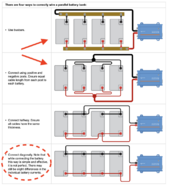tpenfield
New Member
While we are concerning ourselves with wire and bus bar resistance and the potential voltage differences . . .
00 AWG copper has a resistance of approximately 0.079 ohms/1000 feet.
My 33 inch battery lead wires (call it 3 feet) have a resistance of . . . 0.079/1000 x 3 = 0.000237 ohms
@ 100 amps current (per battery) the expected voltage drop across the wires would be . . . 0.000237 ohms x 100 amps = 0.0237 volts.
Figuring voltage drop across both the + and - leads . . . 2 x 0.0237 = 0.0474 volts
Of the several boats that I've owned over the years, this boat has the largest size wiring of all of them. I think my other boats had only 2 AWG wiring by comparison.



